As someone who’s becoming somewhat seen as an opinion leader within the break-in screenwriting world, I get approached by people all the time asking me to judge their competition entries, read their books, and try out their software. I almost always say no because their business operation is often predatory and against the interests of my peers or highly misleading and spreading information I consider dangerous to career development. I’m a working writer-producer so I know what actually makes a difference and perhaps that’s why Prewrite caused me to stop in my tracks and give it a second glance.
I can’t tell you how often I get asked to review books on “how to sell a screenplay” by people who’ve never sold a screenplay. It has turned me into a cynical husk of a human-being who often responds to those emails with a bark of “thanks but no thanks” before adding another name to my avoid list. Sometimes however, there’s something that catches my eye, looks promising, and results in me throwing a bone back. When I was asked to check out Prewrite, a browser based screenwriting tool designed to help screenwriters develop their story, my ears pricked up. However, I have my own well developed pre-writing system called Turn & Burn, something that’s proven critical in helping me break in, so I told the developers as such and their response was unexpected — they implemented my structure it into their software, humbling me in the process and giving me every reason to check Prewrite out, something I’m glad I did.
Now, the concept of pre-writing comes up now and then in screenwriting communities and the responses can easily mislead aspiring screenwriters hoping to improve their craft. The comments often fall into two clear camps; those who pre-write (synopsis, outlines, treatments, scriptments, etc) and those who say they prefer to “keep things natural” by diving into page one with no real plan.
I’m telling you now that the latter is nonsense. EVERYONE pre-writes in some capacity, it’s just that some don’t do it formally by writing a lot of it down before they start drafting. Those who do not spend conscious time pre-writing tend to be one of two kinds of writer;
- Highly experienced professionals who’ve developed so many scripts, story development has become second nature.
- Naive amateurs who are either too deluded or lazy to realise developing their story structure first will save them work in the long-run.
I don’t think I need to tell you which one of those two you’re likely to be conversing with on your average screenwriting forum. So be warned.
Jumping into a new script with nothing but excitement and inspiration sounds romantic. Hell, it sounds artistic. Plus, the “re-writing is writing” axiom provides a comfort blanket those people to clutch on to, helping them convince themselves what they are doing is not just professional but highly professional. It’s not. I’m sorry but a lot of re-writing is a case of desperately trying to glue the off-cuts back on after realising you’ve cut the planks too short. It ain’t pretty and it ain’t efficient. It’s the “we’ll fix it in post” joke for the writing world.
A highly skilled photographer pre-photos every shot they take as their art-form allows little correction to major flaws like poor alignment or lens choice. A professional composer may ad-lib a flurry of notes to find the right melody but the rhythm, tone, and key is something carefully planned out beforehand to define an overall soundscape. Even the most radical of abstract painter still appreciates colour theory, proportions, and movement before picking up a bucket of paint and throwing it rebelliously at a canvas. All screenwriters pre-write in some capacity and it pays for us to engage in deliberate-practice rather than simply hoping we have some sort of unappreciated natural talent. Since something as efficient as a screenplay needs every beat to justify its existence, writing a script without a map is one thing, writing a script without so much as a compass bearing is a recipe for a drawn out, stress filled disaster of a writing experience which will only likely end in a painful rewriting process requiring numerous page-one rewrites. That’s not romantic and, I can assure, no producer will be impressed by a writer who’s clearly throwing mud at the wall and seeing what sticks.
I’ve been arguing the merits of pre-writing for some time now and, as a result of embracing it fully, my first drafts are pretty much my final drafts both in terms of spec-scripts and writing assignments. My development process is also significantly faster as a result and, I’d argue, more enjoyable since I get to throw myself fully into the fun parts after laying the groundwork. I can also do the following — I can sit with a director, producer, actor, or executive and break everything I’ve done down to show the workings. That’s important and, if you’re a writer on set, sometimes crucial.
The only problem with pre-writing is that it’s far from sexy in it’s nature. At least a photographer gets to tour their scene and play with their composures. At least a musician gets to experiment with beats and toy with instruments. At least a painter gets to experience the aesthetic of their medium to the point it’s even tangible. Pre-writing is all too often paragraphs of digital notes on virtual blank sheets of paper or, if you dare to stumble into the Beat Board or Story Map sections within Final Draft, an experience more akin to the tunnel of terror scene in Willy Wonka & the Chocolate Factory — I WISH TO GET OFF THE BOAT, WONKA!
Prewrite, as a software solution, changes that. It makes pre-writing a lot sexier, sexier to the point you feel proud of your project at a conceptual level, sexier to the point it’s highly motivating, sexier to the point it makes you want to put in the essential work of developing a well structured story. I’ll explain how it does that and how it’s really tempting me away from my piles of ugle black and white monospaced notes.
A Brief Tour of Prewrite
It’s best to think of Prewrite like the database behind your story. Within that database, you have table of scenes, a table of characters, a table of plots, etc and you can view all the content you put into it in a variety of ways. This is really quite powerful. Imagine all those documents you may already create detailing your ideal cast, your story structure, your key beats, your plot threads, and so on are interlinked in many ways to make your life easier.
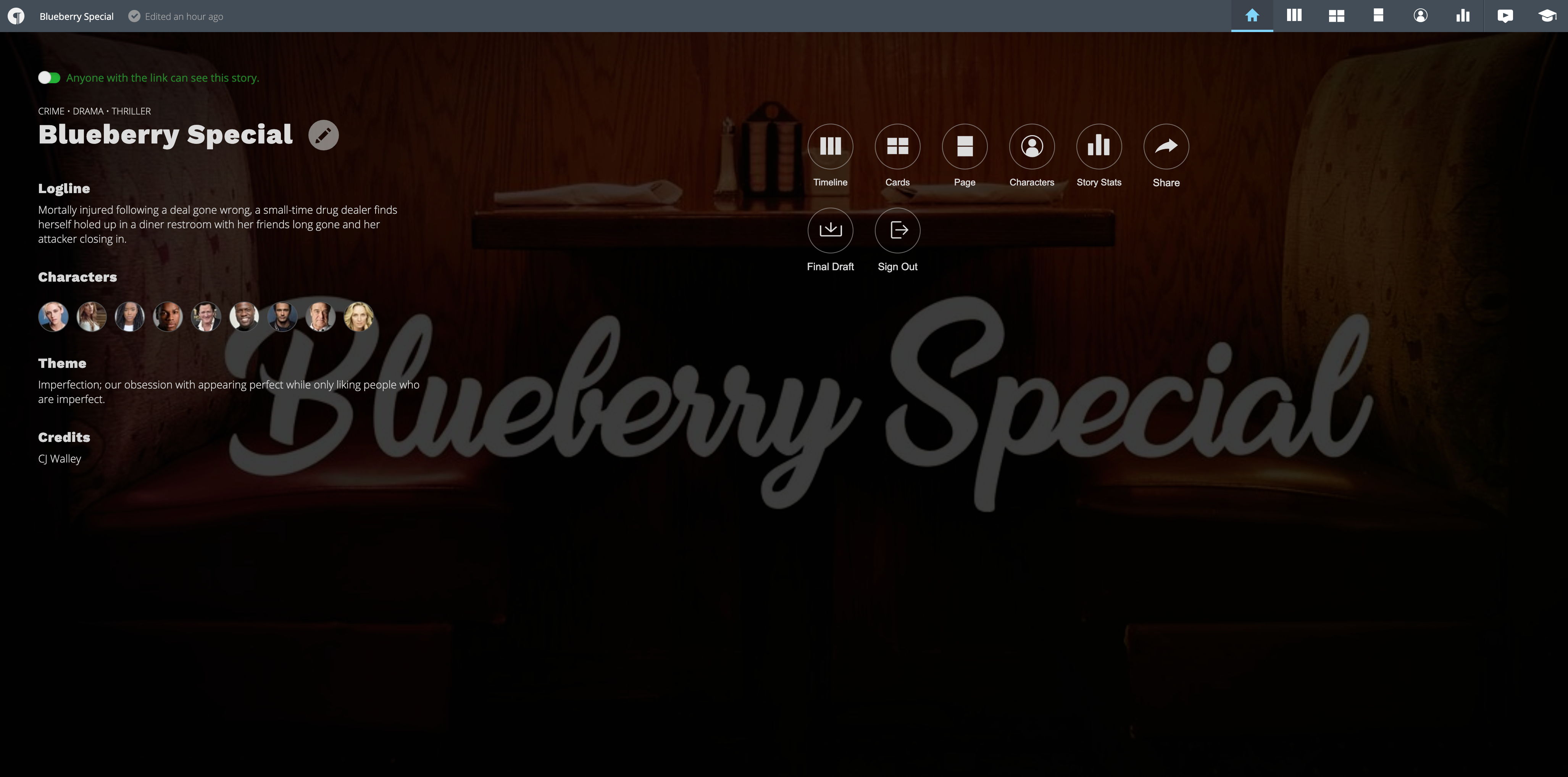
Each story gets a home page which consists of the basics; title, genre, logline, theme, and credits with the option to add a background image to help set the tone and will include any characters you add. The characters themselves are added via a dedicated cast page in which you can input the usual name, age, gender, and race but also their archetype along with their wants and needs. The latter really shows how Prewrite is configured to get you thinking about the fundamentals of your story rather than the superficialities while the former provides statistical data I’ll come back to.
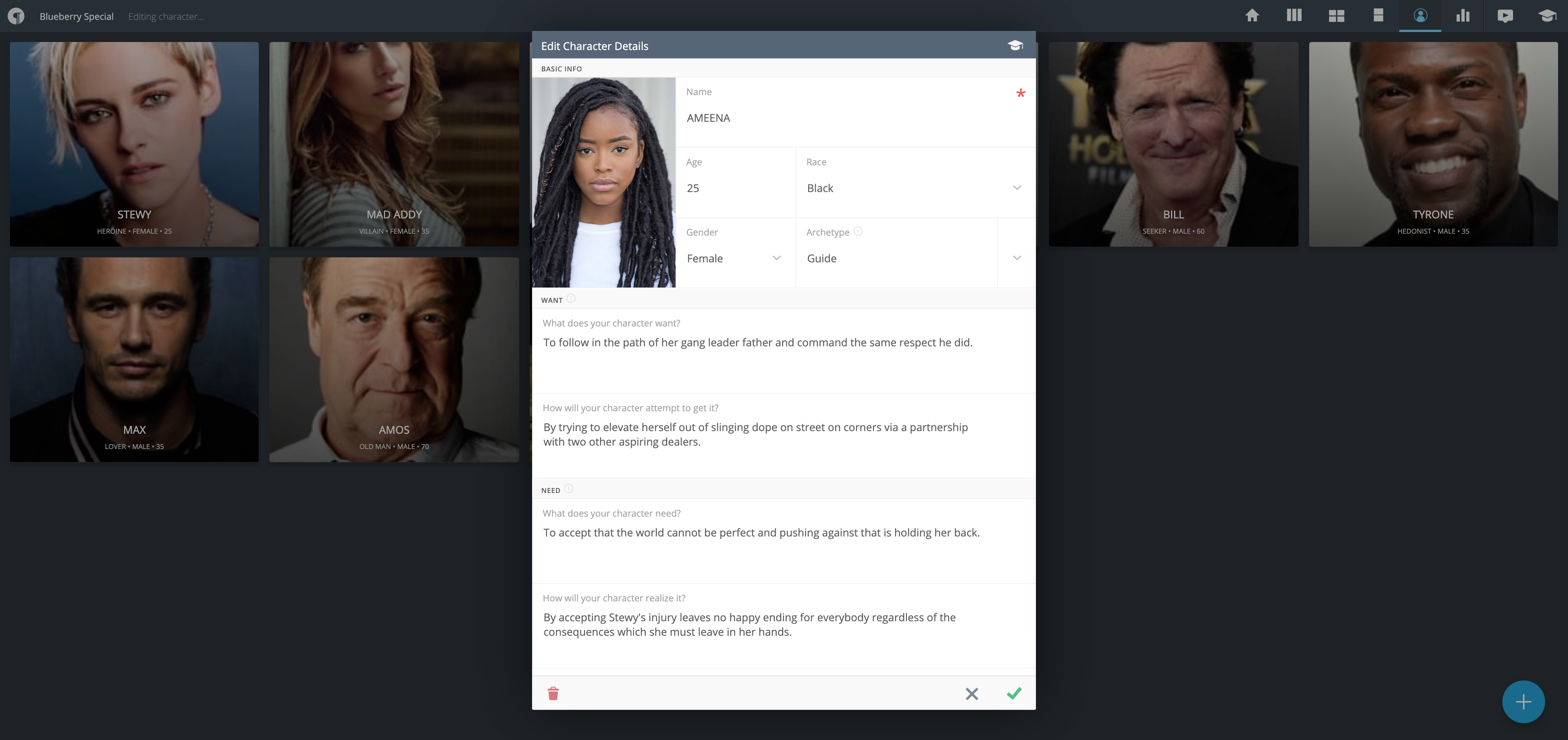
Now, some superficial elements are fun and something I really like about Prewrite is it allows you to add headshots for your characters by linking to the The Movie DB API. If you fancy Dwayne “The Rock” Johnson for your lead, you can simply bang his name in there and get on with developing with his face automatically added and staring right back you — although hopefully not giving you the People’s Eyebrow while he does it.
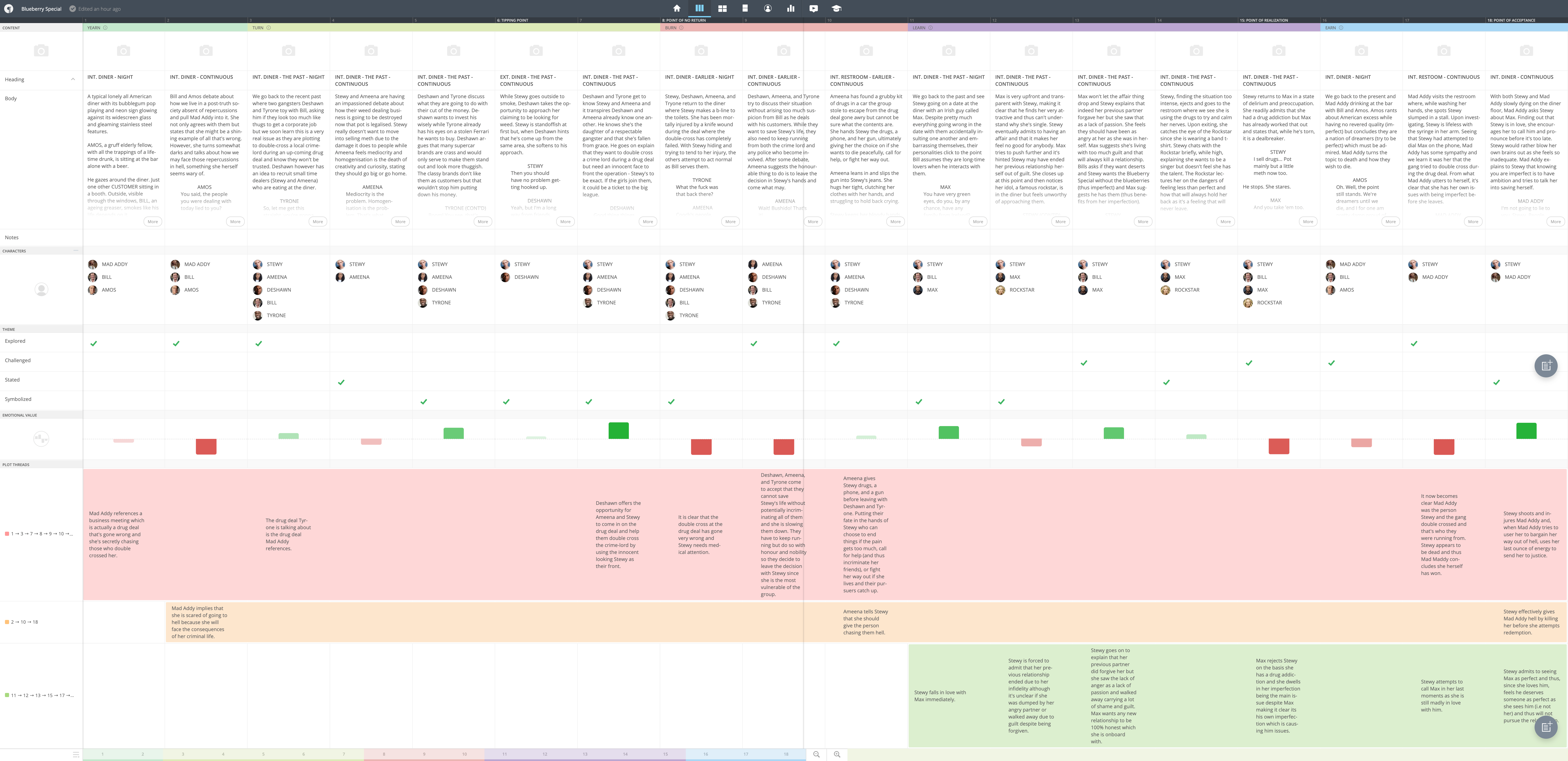
The real meat and potatoes however is the timeline section. This is where your scenes go and it can be built around a selection of pre-defined story structures to make your life easier including, as I mentioned earlier, my Turn & Burn structure should you wish but also the likes of Save the Cat or a basic three act template. Prewrite even gives you some guidelines for the various structures you can chose and provides links for more information. You just pick what works best for you and you’re off to the races with what looks similar to a spreadsheet.
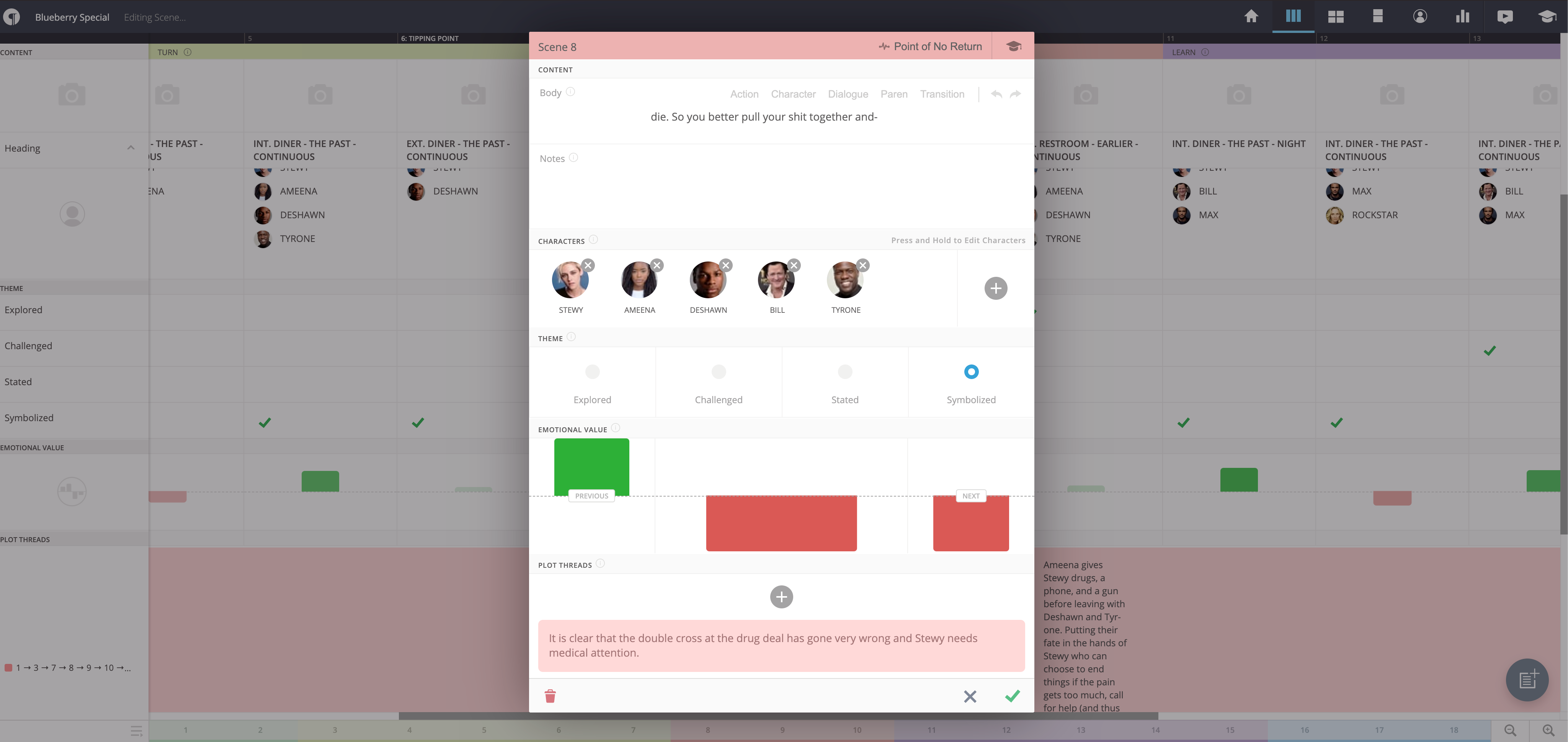
From here you simply drag new scenes into the columns of story sections and, for each scene, you are able to add formatted script content via a very neat little editor, scene notes, characters, how the theme is addressed, the emotional value of the scene, and any plot threads it contains along with an image to set the tone and any major plot beat it may be associated with. You can then move your scenes around to your heart’s content all resulting in a highly organic feeling development system where many of the headaches associated with keeping data together are avoided. Long story short, no more having to hack together your own templates and string them together like the basement wall of a paranoid conspiracy theorist. Think of it like an index card system on steroids.
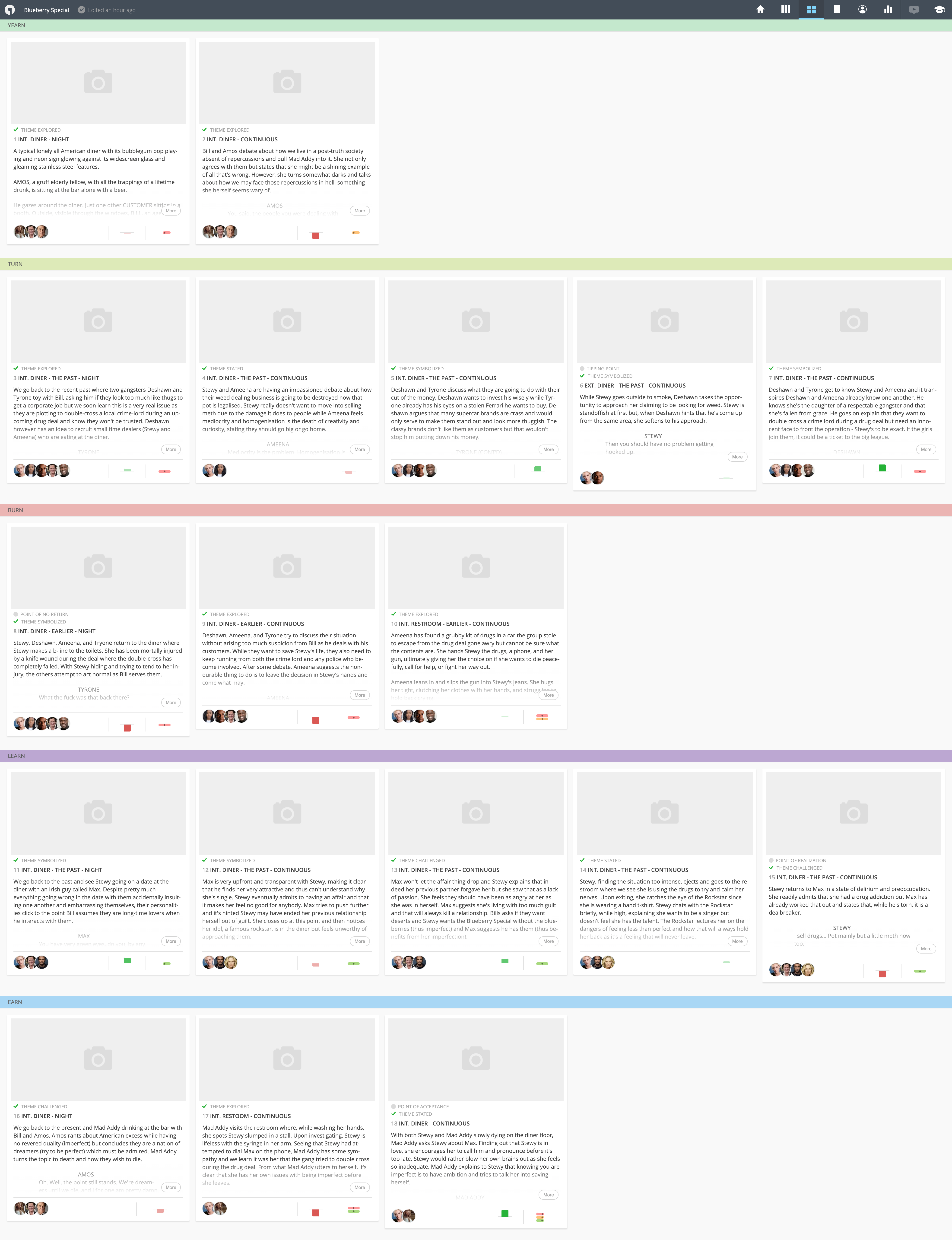
Talking of index cards, Prewrite enables you to switch over to see your scenes in that format if it’s helpful and this will quickly demonstrate just how limited index cards actually are compared to their timeline feature.
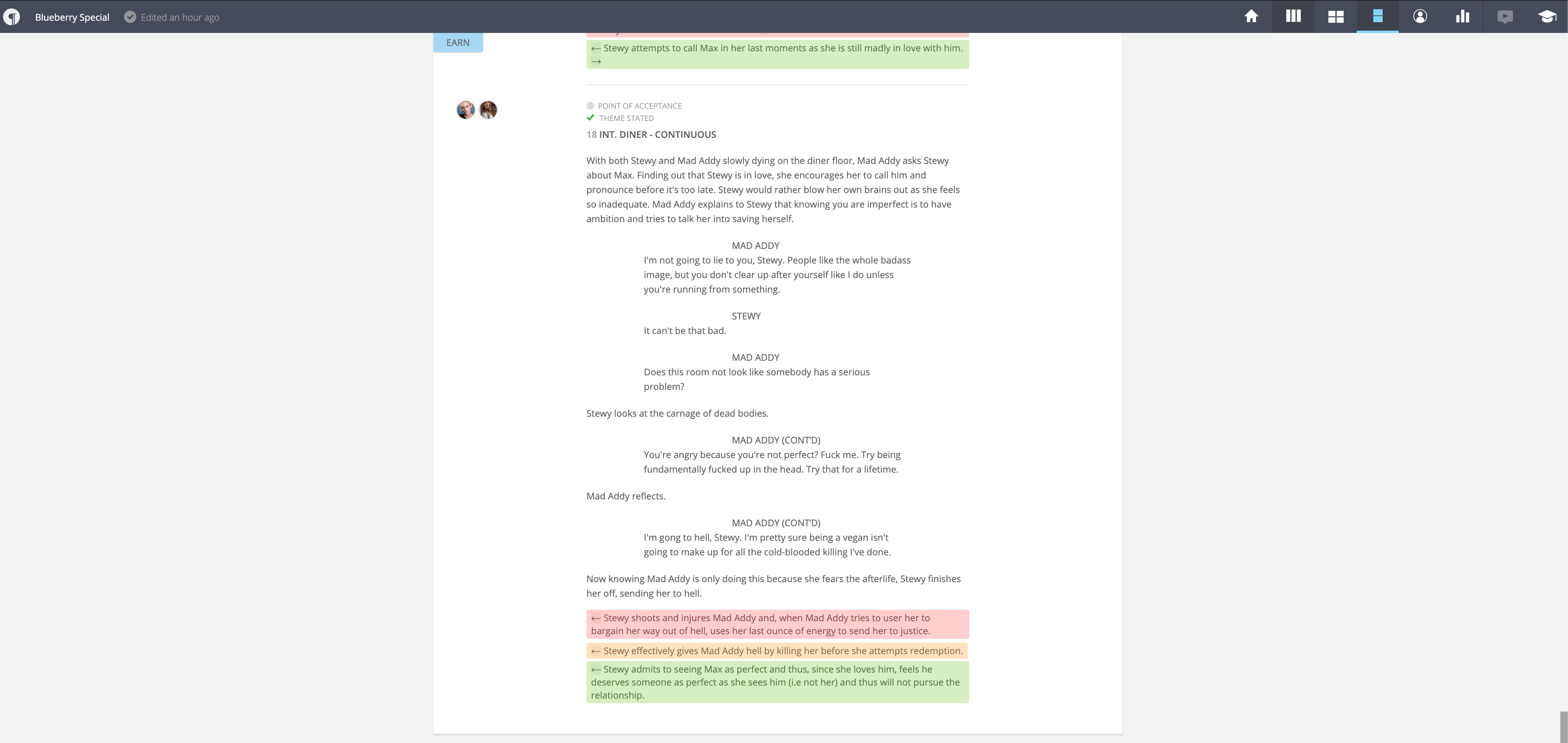
In addition to this, there’s also a page view which allows you see all your content laid out in something close to typical script format with all your notes, plot points, characters, theme references, and major beats included. I have to say, as a huge fan of writing scriptments, I really do like this view as it shows how good systematic pre-writing effectively builds a script from the core story outwards.
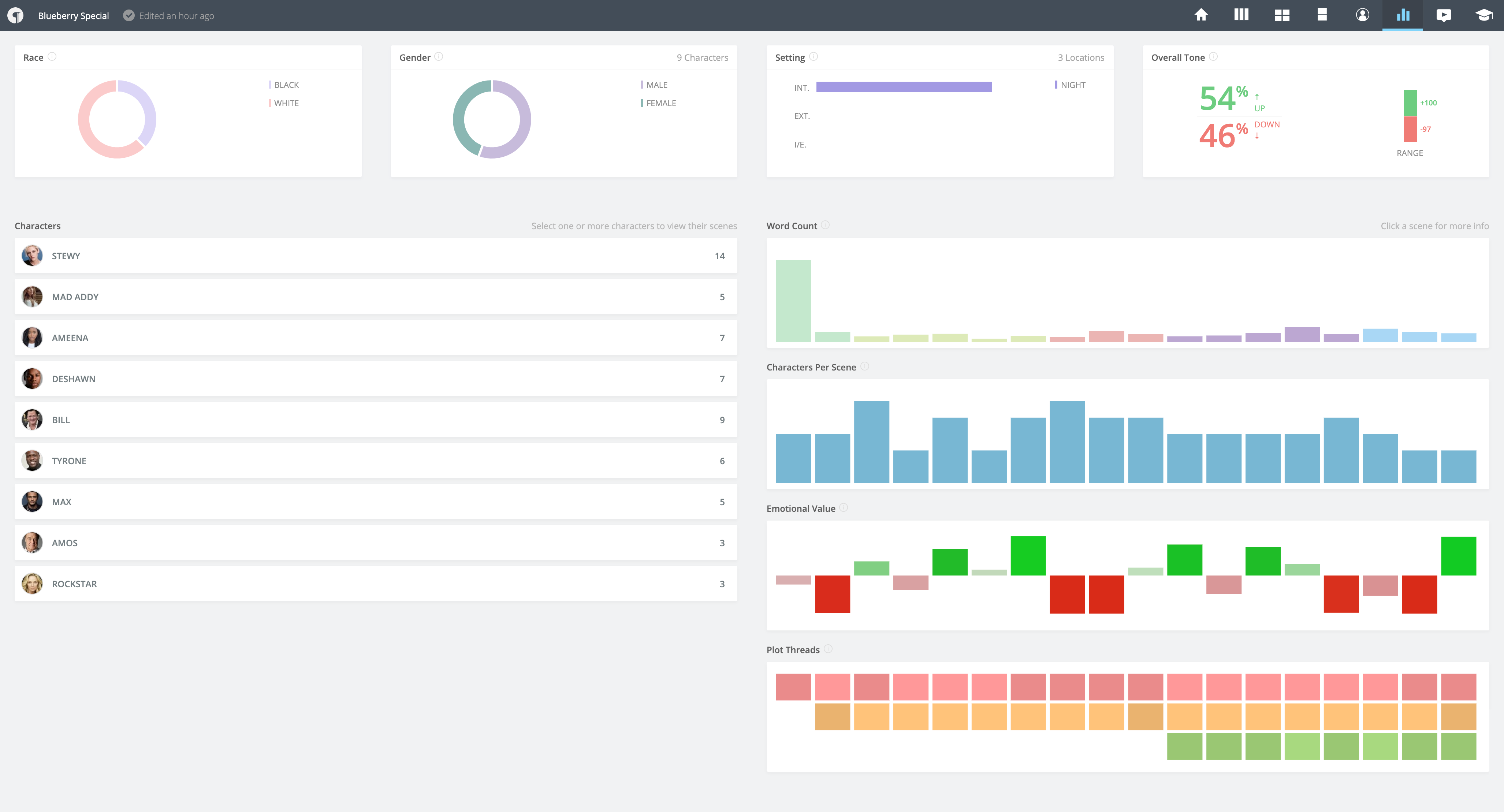
The final main section is the Story Stats page which collates data from your characters and scenes to give you various breakdowns such as gender/race diversity along with tone and the flow of emotional value. This is something I’m seeing more and more in script writing software but is typically dependant on analysing a completed script rather than empowering the writer and their collaborators at the development stage. If you are trying to hit targets, this could really help you.
And speaking of collaboration, this is another major selling point of Prewrite; you can share a link to your project and allow people to see how you’ve structured your story. No need to print off a pdf. They can go through the various sections and get an overview easily without messing up your work. They can tour through a story that feels professional and tonally rich.
In fact, you can go see my own most popular spec script “Blueberry Special” in Prewrite right now by clicking here and see how that fits into my own Turn & Burn structure complete with the major story beats. How cool is that? Spoiler alert; it’s pretty freakin’ cool.
Post Prewrite
Ultimately, by encouraging you to fill in the essential building blocks of your story, Prewrite empowers you with a fluid creation of synopses, treatments, scriptments, or even full scripts. You could, in effect, write an entire, screenplay through its software and that takes me onto the next question; how does Prewrite play with other programs in the script writing process?
The good news is that is plays very well as it can output your scene content into a .fdx file, thus allowing you to import that into your favourite editor such as Final Draft, Scrivener, Writer Duet etc. I can confirm it does this perfectly. So, there’s how it fits into your workflow. No excuses.
Prewrite vs…
If you’re current pre-writing process consists of various documents and spreadsheets all kept in a file folder on your computer, Prewrite will be a god send. It will make your life a lot simpler and easier and possibly make your scripts better in the process, particularly if you are a writer new to the concept or struggle with story structure.
If you’re currently trying to pre-write via Final Draft using the Beat Board then Prewrite will feel like a breath of fresh air as it is so much simpler to use while also being much more sophisticated at the same time.
Now, if you’re a Scrivener user like me, the choice is harder. Given that Scrivener is developed by actual novel writers, it has its Scrivens system at its core and thus you can break a screenplay down to sections and scenes while also keeping all your development docs within the same project. All of those “scenes” can also have their own notes, header images, and meta-data too, building a similar database to Prewrite but without the alternative overviews, character database, plot threads, or statistics. It’s just ugly, really ugly and, short of outputting pdfs of text, there’s no easy way to collaborate.
So, Would I Switch to Prewrite Tomorrow?
You know, I’m sorely tempted. While Prewrite doesn’t have the detail contained in my own scene building worksheet built into it, I can copy and paste my worksheet into the notes section and fill it in there, which is what I currently do in Scrivener anyway. I could then copy and paste the beats I establish from that into the body for each scene, giving me a scriptment that I can export in .fdx format and take into Scrivener or Final Draft for drafting.
I do love how Prewrite makes a story feel in the early stages and links everything together and, on a treatment level, I could give my producers a link to view the project rather than a pdf which would likely impress them.
I also really wish Prewrite had existed in 2013 when I was a year into screenwriting and, after reading various craft books, creating my own spreadsheets to help me break down scenes and form better story structures. Not only would it have streamlined my story development, it would have taught me a lot about structure in the process.
Right now, I’m close to jumping in with both feet. The only major component I feel is missing, and this tends to be missing from all screenwriting software except Scrivener, is a snapshot feature that allows me to save a draft of a scene and view/rollback to it at any time. I’d also ideally like some of the key elements of scene structure (such as PASTO) to be built in with the emotional values section broken down more into factors such as action, humour, emotion, and tension. It would also be cool if the section on addressing theme encouraged the writer to add text here as writing this stuff down is often how we process it. However, as mentioned before, this can all be done easily enough via the notes sections and, based on my conversations with the developers, I’m confident new features will continue rolling out each month.
Ultimately, this is a software tool in the very early days with a developer who’s keen to listen to feedback and implement the features screenwriters need. That excites me a lot. With almost every other piece of screenwriting software out there being focused on composing scripts rather than developing stories, I feel Prewrite is looking at the bigger picture and that’s something writers hoping to turn pro really need to be encouraged to do.
To conclude, Prewrite empowers the storyteller deep within the average screenwriter while offering a helping hand and streamlining their process. Those writers trying to break into Hollywood don’t need another formatter, they need a structure builder while working professionals can benefit from a slick interface that allows them to build flexible treatments complete with visual elements and statistical breakdowns that can easily be shared with their fellow industry members. I highly recommend it.
Don’t take my word for it though. You can go try Prewrite for yourself for free right now by clicking here and seeing how it works for you by creating a project and following the introductory tour.

